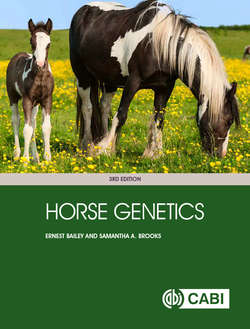Читать книгу Horse Genetics - Ernest Bailey - Страница 8
На сайте Литреса книга снята с продажи.
ОглавлениеPreface to the Third Edition
Horse genetics has not changed since Ann Bowling wrote the first edition of this book; however, the tools have changed profoundly. The gray coat color allele is still dominant and normal horses still have 32 pairs of chromosomes. Yet, today, the whole genome sequence for the horse is freely available on the internet and we can use molecular genetic tests to reaffirm many of the observations of horse breeders, to refine others and to discover aspects of the horse that we could not imagine.
The first edition of this book was published when DNA studies were first being applied to the horse. The second edition followed completion of the whole genome sequence of the horse. Now, seven years later, over 2000 horses have had their whole genomes sequenced, DNA tests using ancient horse bones have revolutionized our understanding of horse domestication, and the studies on regulation of gene expression have become the cutting edge of genetics research for the horse.
We do not need to be molecular geneticists to use this information. We can buy commercial DNA tests for coat color traits and disease susceptibility genes. Therefore, the purpose of this book is to provide basic information on genetics in an easy-to-understand format. As before, the book includes introductory chapters on basic genetics that review terminology and fundamental concepts. At the same time, the text contains very specific information about the DNA variants associated with traits, scientific speculation about how those traits came to be, and advice on how to apply the wide variation occurring among horses. It is not a book to read through at one sitting. The reader may want to simply peruse the table of contents and select sections pertaining to their interests. References are included to the original work if the reader wants details; however, these detailed studies are not necessary for a useful understanding of this new information.
The book covers a wide range of topics but not everything. This is an introductory text and we hope the lessons learned from the material in the book will make it possible to follow and understand the many exciting discoveries that did not fit or that are currently emerging areas of interest.
Finally, this edition is dedicated to the memory of two colleagues who shared a passion for horses and horse genetics, and made some of the discoveries described in this book:
Ann Bowling, PhD; June 1, 1943—December 8, 2000
Teri L. Lear, PhD; October 10, 1951—May 16, 2016
Respectfully,
Ernest Bailey, PhD
Samantha A. Brooks, PhD
2019
